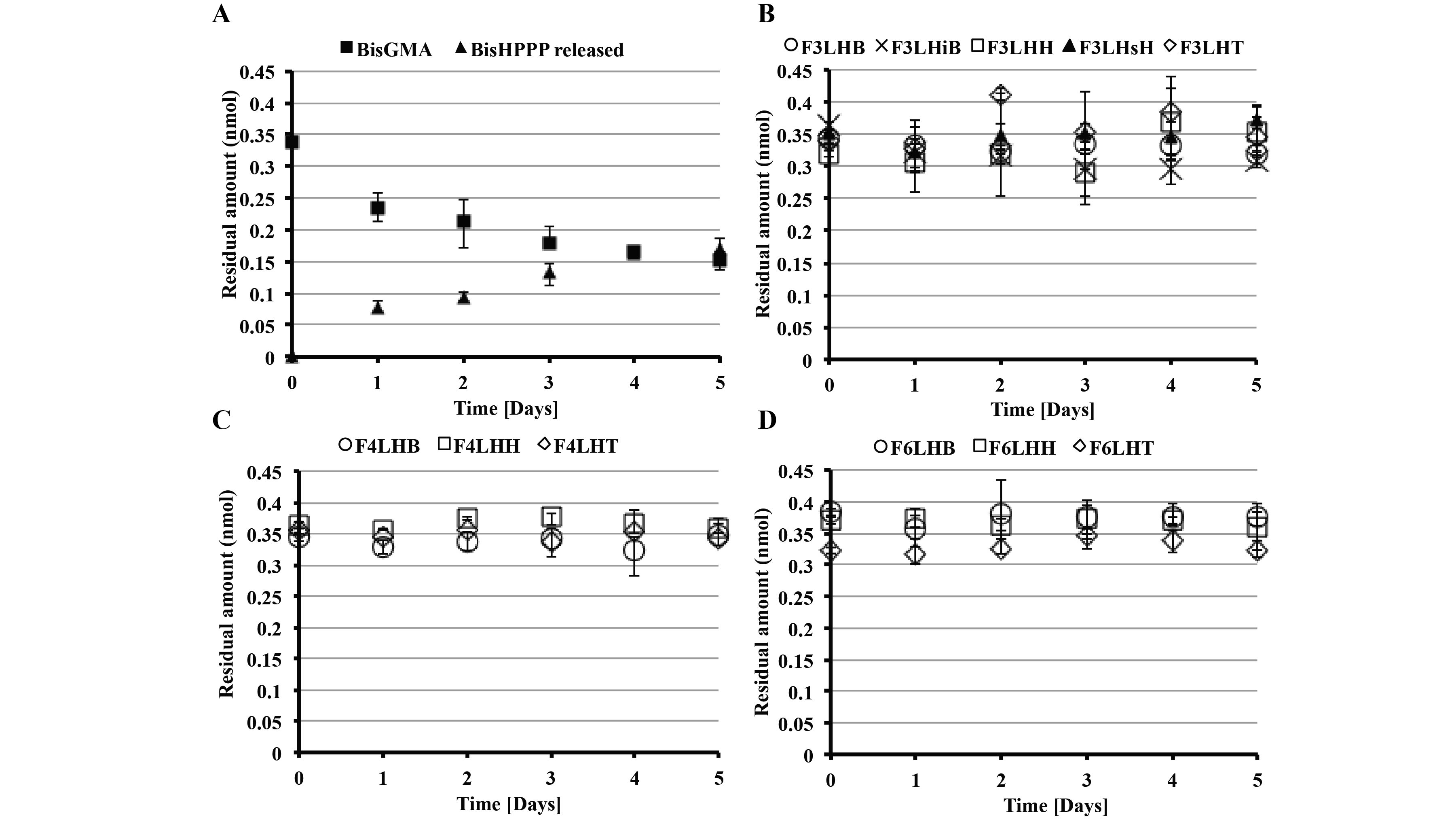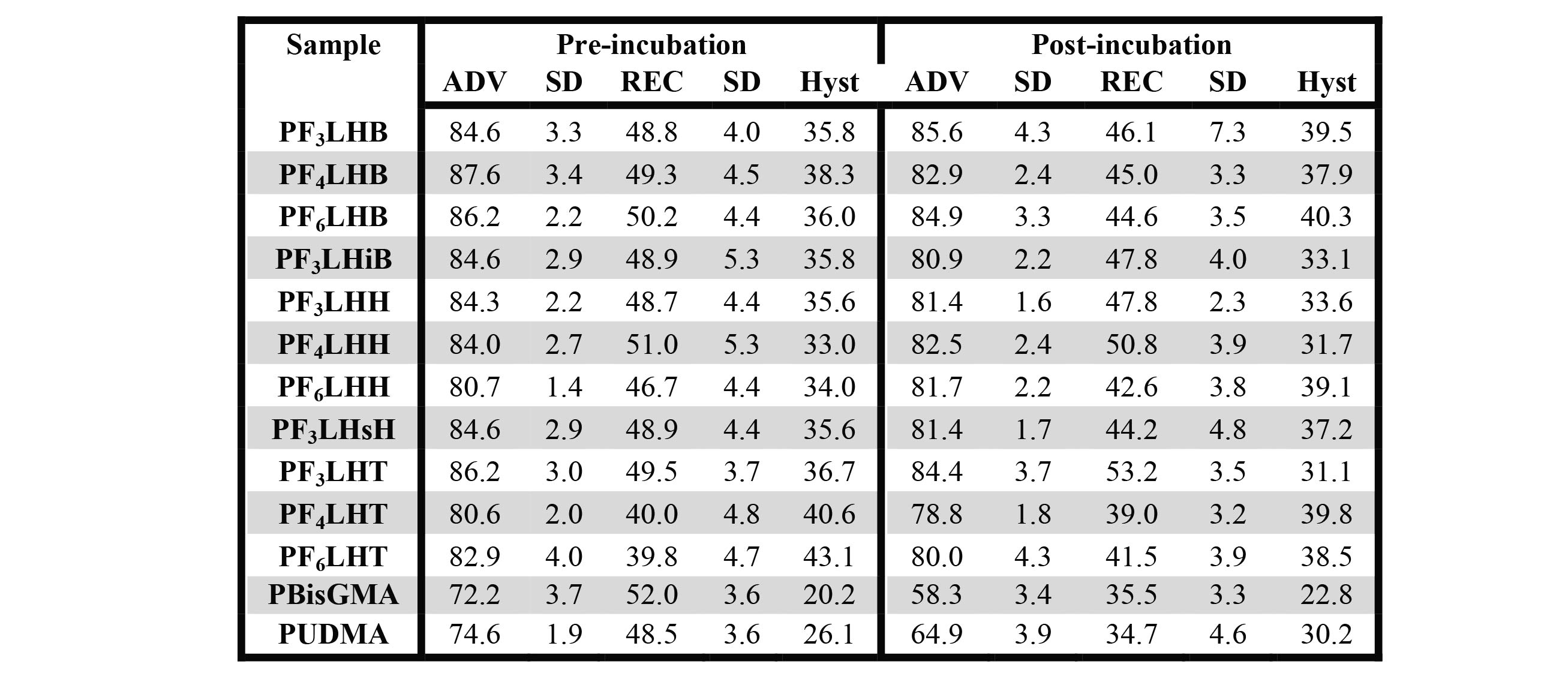Introduction: Resin composites lack longevity due to the inherent hydrolysis of their chemical structure in the oral cavity[1]. Previous work[2] showed mechanistically how urethane associated hydrogen-bonding could be used to enhance the hydrolytic stability of ester bonds in these systems. Subsequent synthetic work by Yang et al. introduced monomers with fluorinated moieties around the urethane chemistry[3]. The objective of this work was to assess the monomer’s biostability, and determine protein adhesion of polymerized resins generated from di-methacrylate monomer that combined the fluorinated and hydrogen bonding urethane chemistry.
Methods: Fluorinated hydrophobic monomers (FxLHD) were synthesized as previously described[3] using short chain ether and non-ether diols, perfluoroalcohols and lysine diisocyanate (LDI), with 2-hydroxyethyl methacrylate (HEMA) substituted for the methyl ester of LDI units to generate a di-vinyl monomer. Degradation studies (n=3) were performed by suspending monomers for 5 days in the presence of human serum albumin (HSA) with 5 units/mL cholesterol esterase (CE)-like activity in 20 mM Tris, 2 mM CaCl2 and 5 mM MgCl2 (pH 8.8)[4]. Test monomers were compared to an established control dental monomer, bisphenol A-diglycidyl methacrylate (BisGMA). Solutions were then quantified by high performance liquid chromatography (HPLC). Material films were prepared on glass slides using camphorquinone and dimethylamino-ethyl methacrylate as co-initiator, and post cured at 60±2°C. Dry films were characterized by measuring the advancing (ADV) and receding (REC) contact angles of water (n=15, five drops/film, repeated three times), before and after incubation with 1mg/mL bovine serum albumin (BSA) solution for 45 min. BSA adhesion was measured using the bicinchonic acid (BCA) assay. Data were compared to films generated from BisGMA and urethane dimethacrylate (UDMA) commercial monomers.

Figure 1. HPLC analysis of biodegradation products generated from 0.1 mM monomer in HSA, pH 8.8: (A) BisGMA, (B) F3LHD monomers, (C) F4LHD monomers and (D) F6LHD monomers.
Results: 55% of BisGMA control had undergone degradation and produced the terminal degradation by-product, BisHPPP. However, no visible biodegradation was observed with the FxLHD monomers (Fig 1). The change in ADV of the FxLHD films upon exposure to 1 mg/mL of BSA (Table 1) was less than ~5°, in comparison to the polymerized controls UDMA (~10°) and BisGMA (~14°), possibly suggesting less protein adhesion to the FxLHD films. However, BCA data showed no significant difference in BSA absorption between the tested samples. Contact angle hysteresis was greatest on FxLHD samples relative to controls, implying greater surface dynamics.
Table 1. Contact angle (°) measurements, values are reported with standard deviations (SD) for dry films before and after exposure to albumin.

Conclusion: Hysteresis data suggest that relative to controls, the novel monomers appear to change the chemical interaction of active protein and enzyme with hydrolyzable sites, but that lower hydrolysis for FxLHD is not enabled through reduced protein adhesion. On-going work is investigating differences in bacterial adhesion onto the FxLHD films to determine their potential to minimize bacterial induced hydrolysis.
NSERC CGS and NSERC Discovery Grant #360520
References:
[1] Delaviz Y et al., Dent Mater 2014; 30: 16-32
[2] Finer Y and Santerre JP, J Biomater Scie Polym Ed 2003; 14: 837-49
[3] Yang M and Santerre JP, World Biomat Cong, ChengDu, China, 2012 abst #1355
[4] Kai C et al., Dent Mater 2014; 30: 848-860